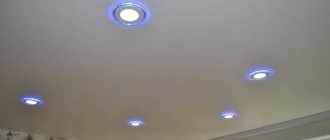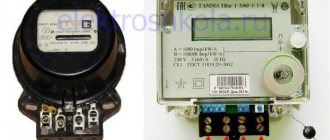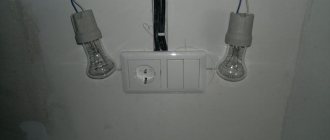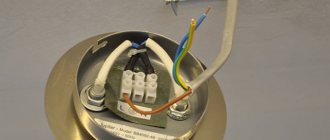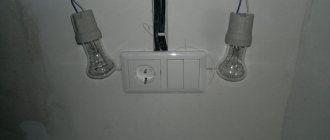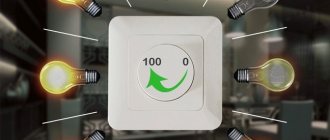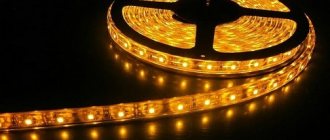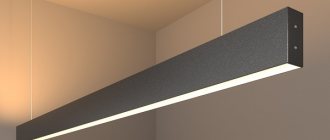The chandelier not only complements the overall design of the room, but also serves as a source of light in the dark. However, the maximum possible level of illumination is not used very often, right? For the most part, there is a need to use the economy mode, when only part of the lamps are functioning.
For this purpose, connect the chandelier to a double switch, which allows you to adjust the intensity of the room lighting. Do you want to install the switching device yourself, but don’t know how to do it correctly?
We will help you understand all the nuances of this process - the article provides diagrams for connecting the device to a switch with two keys, and discusses the main mistakes that beginners make. Correct connection of the wires will allow control, providing comfortable lighting.
The article contains photographs, diagrams and recommendations in video format on how to correctly connect a chandelier on your own. Having studied the basic rules and installation diagrams, you can begin to work.
Safety first
Work with electrical wiring must be carried out in compliance with safety precautions and following a clear sequence of actions.
First of all, the rules concern de-energizing the wiring during the process of fitting and stripping wires, installing the operating mechanism of the switch, connecting conductors to terminals and other actions.
The main aspect that you should pay attention to when performing home electrical work is contact with exposed wires. All actions must be performed after turning off the general switch and using special tools
However, to determine the required wire, you will still need a power supply, so you must be as careful as possible in your work and perform all actions only with special tools with high-quality insulation of the handles.
The figure shows that 3 conductors are suitable for the double switch, one of them is directed from the distributor, and the rest are used for contact with the chandelier. The electrical wiring is aluminum and is represented by a three-core wire
Installation of a double switch is carried out only in the phase conductor gap.
When inspecting the completed circuit, it is allowed to turn on and off the lighting fixtures only after complete isolation of the exposed conductors and their final fastening.
Application of double switches
Connecting the chandelier to the electrical circuit with a double switch allows you to both turn on a group of lamps one by one and turn on the lighting device at full power.
In this case, a two-phase device can operate by interacting only with two groups, the number of lamps in which is not limited.
Using a two-key device, you can connect any two lighting groups that require parallel or alternate activation. In this case, the scheme undergoes virtually no changes
Such control fittings can be used in a private house, where the first line supplies external lighting, and the second - the corridor, also in apartments, distributing power between two bathroom rooms.
A two-key switch is a pair of single-key switches equipped in one housing, so the connection diagram is almost identical.
To reproduce the installation plan, you must first become familiar with the design features of the product and the elements connected to the electrical network.
We will prepare the necessary
Chandelier connection tool
Since all electrical work involves the risk of electrocution, hanging and plugging in your new chandelier will require you to be careful and focused. Therefore, prepare all the tools and small things in advance so that they are at arm’s length. Here's what you'll need:
- a set of screwdrivers with different heads;
- indicator screwdriver;
- multimeter;
- pliers with insulated handles;
- terminal clamps;
- knife and electrical tape;
- a stable chair or stepladder.
Device design with two keys
There are a lot of modifications and types of light switches. However, two-key electrical accessories gained popularity relatively recently, when lighting began to be reproduced using multi-lamp chandeliers.
Thus, the need arose for light distribution through zoning with spotlights.
No. 1 - self-clamping terminal block model
The device body has standard parameters. Depending on the modification, it can be overhead or built-in; it can be easily mounted on the external or internal part of the wall.
The second type is equipped with adjustable clamps. Using screws, the device body is secured in the desired position.
The design of the two-key device contains two independent mechanisms, through which the connection and disconnection of the electrical network circuit is carried out
To fasten wires, modern fittings use plate clamps or a clamping strip with screws.
The screwless model has become widespread and is simply indispensable for self-installation for beginners. The connection diagram and pin distribution are in most cases shown on the back of the case. Conventional labeling values are also used.
The main symbol is the Latin letter L, meaning contact for the phase wire. Nearby there are a pair of arrows pointing down. They are interpreted as indicating the direction of the two outgoing phases. The numbers indicated in place of the arrows carry the same meaning.
In this German two-position switch, the phase wire is connected to the terminal marked L, and the outgoing phases facing the corresponding keys are connected to terminals 1 and 2
The double contacts of the first switch key are located on the left side, and the second one on the right.
Based on the connection method, each of the keys can provide voltage in different directions, for example, turn on several lamp bulbs or illuminate a room located nearby.
Each of the conductors has its own purpose, so the best option is to use a cable with cores of different colors. This will significantly simplify and speed up the electrical installation process.
No. 2 - connecting a screwless model
The process of connecting self-clamping contacts is much simpler compared to screw contacts. First of all, turn off the electricity supply. Next, all conductors of the future contact must be stripped of 1 cm of insulating material.
Each contact provides for the fixation of one pair of cores. The stripped wire is inserted all the way into the corresponding hole in the mechanism.
After turning on the electricity, you need to calculate the power phase. An indicator screwdriver is used for this purpose. After checking, the current supply must be stopped.
Checking the presence or absence of a phase on the contacts is carried out through special windows, which are provided in the two-phase switch mechanism
Following the diagram indicated on the back of the working part of the switch, it is necessary to connect the multi-colored wires one by one, distributing them among the keys.
Let's look at a detailed action plan using a specific example.
From the electrical panel of the apartment, the power supply enters the distributor in the form of a pair of wires: the phase indicated in red, and the zero – blue. There may also be a yellow-green ground wire next to them.
In our example, the red power phase is connected to the red wire that goes to the common contact of the two-position switch. The output from it already produces two wires - burgundy and yellow.
The burgundy wire is directed into the junction box. There it is connected to a contact identical in color and goes to the first group of chandelier bulbs.
According to the diagram, the yellow phase contact going into the distributor must be connected to a wire of a similar color going to the second group of lamps.
The zero, shown in blue in the diagram and also coming from the apartment's electrical panel, goes directly to the distribution box, and then to the terminal block, where the zero of each group of chandelier lamps is connected.
Similar to the zero vein, there is a yellow-green one, which is responsible for the ground.
Be sure to check the reliability of the contact clamp - you need to lightly tension the cable. If there is a need for any corrections, you should press the button on the end of the desired contact. In the picture L is a contact for connecting a phase
When installing and connecting a double switch, its operating mechanism is hidden in a socket box, secured in the desired position with a screw fastening. Next, keys and a decorative overlay are placed on the device.
No. 3 - installation of screw contacts
In this case, there are no schematic instructions. Visually, it is necessary to identify the two lower contacts, which most likely represent the outgoing phases, and the upper one, the supply phase.
You can verify the correctness of the actions by methodically turning the contacts on and off: when the keys are on, the circuit is closed, in the off position, the circuit is opened.
Depending on the manufacturer, the terminal designations may differ. In this Chinese switch, the marking is presented as follows: L - common phase, outgoing phases L1 and L2
The mechanism of this type of switch is equipped with three screw contacts through which the cores are connected, and two screws that activate the spacer tabs.
The power phase (1) sits on the top single contact, the two bottom contacts connect the outgoing phases of the lamp (2), the spacer screws are located on the right and left sides of the device (3)
For screw-type contacts, it is necessary to strip the cores by 0.5 cm. The cores are fixed using a plate driven by screws.
Checking the correct connection of wires
The first priority is to inspect whether the switch was connected correctly. On one of the lines, the voltage indicator in the open position should indicate the presence of phase potential.
At the place where it is planned to install the chandelier, two wires should come out, namely the neutral and phase wires coming from the switch.
The number of conductors in the device itself will be greater, especially when a multi-track lamp is connected. It is also possible to have a grounding conductor if the house uses electrical wiring with a TN-CS grounding system.
If the check failed to detect a phase, this indicates an incorrect wiring connection or problems with securing the wires in the operating mechanism of the switch
To correctly assign the purpose of each cable, it is necessary to check whether they have voltage. There are several special devices for this: indicator, voltmeter, digital multimeter, etc.
It is not difficult to work with the voltage indicator: you just need to touch its tip to the area of the wiring that has been cleared of insulation.
Only one cable does not illuminate the device - zero, the rest, when in contact with a screwdriver, will cause it to glow - phase. Alternately switching two keys of the switch will help to recognize that the wire belongs to the desired key.
In addition to zero and phase, grounding is additionally installed in new buildings. The yellow-green wire is connected to a similar lamp cable
A similar determination method is used when measuring with a digital multimeter. It must be set in the “Volts” mode and set the scale to more than 220 V. Alternating, you need to touch the pairs of wires with the probes.
The phase pair will not lead to changes on the device dial. By connecting a possible phase and zero with probes, you can see the number 220 V on the indicator. If the wiring has the same color, it is better to mark it with markers.
Wiring continuity
It is not possible to identify a grounded wire in every home. In old buildings they are usually absent. The remaining contacts are also not always marked. To figure out where the “phase” is and where the “zero” is, it is necessary to carry out a dialing.
So, with a two-key switch device, you may need to connect a chandelier with three wires, two of which will be phase, and one will be neutral. To determine the voltage, you need an indicator screwdriver, a tester (multimeter) or a voltmeter.
During the call, the switch key must be in the “ON” position; accordingly, the electricity in the room must also be connected. Upon completion of the work, it is necessary to switch the key to the “OFF” state and turn off the machine on the control panel or unscrew the plugs.
Voltmeter
One of the measuring instruments often used by craftsmen to determine voltage is a voltmeter. Its main advantage is its ease of operation, as well as the absence of the need for an additional power supply (batteries). When working with it, you must remember that its operation must be carried out parallel to the source of electricity and it must be in a strictly horizontal position.
Determining contact voltage using a voltmeter is a simple task. It is enough to fasten the probe wires to the contacts and track the position of the arrow on the indicator. If the value does not change (is at zero), then both wires are phase, and the remaining wire is zero. Then you should move one of the probes to “0”, and the second one in turn to each of the “phases”. The arrow on the device should indicate a value of 220 V. To facilitate further work, it is necessary to mark each wire with a colored marker or Latin letters, where “N” is the neutral contact, and “L” is the phase contact.
Decoding the markings of electrical wires
For ease of identification and to avoid confusion, the insulation of the cable cores is different colors. According to the standards, the ground wire is yellow with a green stripe.
Such a conductor is found in new buildings, where a high level of protection against electric shock is provided.
In houses with old wiring, deciphering the purpose of the cable is difficult, because... Previously, the color of the insulating material was the same. To begin electrical installation work, you will need to ring the cable (+)
The marking of the neutral conductor is carried out by an insulating sheath of blue or light blue color, in which the core is enclosed. Any other shade variations other than those indicated can be used for the phase.
Connection options
Connecting a chandelier and other lighting devices is done by crimping, soldering or using terminal adapters.
The first option involves connecting the conductor cores by crimping them with a fixing sleeve. The entire procedure is carried out with a special tool - press tongs. This method complies with all regulatory documents.
The second method is considered one of the most reliable, but difficult to reproduce. It is practically not used due to the inconvenience of working at height.
When choosing one of the methods for contacting conductors, you must remember that aluminum under constant load acquires plasticity. Connections of this type require regular inspection. You also need to periodically tighten the fixing bolts.
You cannot twist aluminum and copper wires together - a galvanic pair is formed, which, even with a slight increase in the level of humidity in the apartment, can reproduce an electrochemical reaction in the form of oxidation.
This process breaks the contacts, and the junction begins to heat up. It is for this reason that fires occur.
If you use terminals to connect, you will need to remove 9-11 mm of insulating material from the conductors. For this purpose, there are special marks on the clamps that determine the required level of stripping.
The use of terminal blocks is considered relevant. At the moment, the model range of this connecting element is quite wide - from the classic screw version to the spring modification.
How to connect a chandelier correctly?
If you pay attention to the five-arm chandelier, it has a fairly large number of wires, so inexperienced craftsmen avoid such lighting devices.
However, there is nothing complicated in the process of connecting the wires coming from the distributor to such a lamp.
Since the determination of the phase of the wires is carried out when the power supply is turned on, it is necessary to ensure that the bare ends of the wires do not touch. If necessary, they must be carefully moved in different directions, having first turned off the shield
First of all, you need to deal with the wiring on the ceiling, which in a standard situation has three wires:
- L1 - phase of the first switch key;
- L2 - phase of the second key;
- N - zero.
If the wires are the same color, then using a voltage indicator, the identity of each is determined, i.e., phases L1 and L2. Accordingly, the remaining core will be zero.
Next, you can move on to the process of forming contact nodes. Let's consider the example of a five-arm chandelier, which has 10 wires: brown phase conductors - there are 5 of them, and the same number of blue zero wires.
Most Chinese-made chandeliers are not equipped with the necessary connections, so you will initially need to determine how many groups the light bulbs will be divided into. Each lamp socket has two conductors of different colors - black or blue and brown
This lamp has one undeniable advantage - the combination of light bulbs can be made at your discretion. According to the diagram described below, the first group includes two light bulbs, the second - the remaining three.
Wiring diagram for a five-arm chandelier. Explanation of symbols: L - phase of the general power supply of the switch, L1 and L2 - phase wires of a series of light bulbs (red), neutral cable N - blue
Based on this diagram, the connection of a five-arm lighting device is carried out in several stages. Initially, a pair of brown wires is assembled into one unit.
It is advisable that lamps included in the same series are connected in parallel. We call this twist L1.
The next step is to twist the unused three brown wires in a similar way. This will be the L2 series. Next, the resulting two nodes are inserted into two-wire terminal clamps WAGO .
It is better to make all contacts using terminal clamps rather than by twisting. You can use either a common clamping module or an individual design
At the next stage, the blue wires are twisted and connected to a three-wire terminal.
The order of connection does not matter. The combination can be 3+2 or 2+3. This will be the neutral node - N.
The only disadvantage of Vago terminal blocks is that they are not treated with quartz paste, which protects the contacts from oxidation. However, this problem can be solved by purchasing such a composition and douching it into the clamp yourself
As a result, the output produces 3 connection nodes: the phase of the first and second groups of lamps - L1 and L2, the common neutral node - N. Taking into account the marking of the wires, they must be connected to the corresponding lines on the ceiling.
There are two phase conductors coming out of the lamp (L1, L2), and there will be only one neutral wire (N) and it is connected to the second contact of the socket
At the final stage, it is necessary to lay all the wiring in the block of the chandelier bowl and install it. Fastening is carried out in one of the following ways: hung on a hook or screwed with screws. Next, the decorative plugs of the lamp are tightened.
Important Reminders
To eliminate critical errors, you must:
- Always turn off the power supply before working. Moreover, this must be done on a common distribution panel, de-energizing the entire house (apartment). It is highly not recommended to use only a switch for this.
- All tools must be in good working order and have well-insulated handles.
- Particular care must be taken to ensure that when dividing the wires into groups, the phase conductor does not fall into the zero twist.
- It is better to use special contact blocks. If they are not there, then it is good to insulate all connections to prevent a short circuit.
- It must be remembered that zero is not supplied to the switch. To create a break contact, only the phase wire is used.
- If all the cores used are the same color, they must be ringed and marked.
Using a ground wire
When arranging electrical communications in new houses according to generally accepted standards, there will definitely be a grounding wire in the wiring.
In such rooms, when installing a chandelier, you can find that 4 wires come out of the ceiling: two phases from the switch, zero and ground.
The ground wire is marked with a combination of yellow and a green stripe. In a single-phase network it will be the third residential, in a three-phase network - the fifth
Most models of chandeliers with two groups of lamps and metal parts include a terminal block through which the grounding connection is made.
During the installation of the lighting device, you need to pay attention to this and connect the wire.
We work safely
You will have to work directly with electrical wiring, so it should not be energized at the time of all work. To completely protect yourself from electric shock, you need to not only make sure that the switch is in the “off” position, but also turn off the circuit breakers on the panel.
Attention!!! All work should be carried out only on de-energized equipment.
Before testing the cables, disconnect them and make sure that they do not touch in the future. Cables have accepted markings in Latin characters:
- L – phase wire;
- N – neutral;
- PE – yellow-green ground wire.
You may be interested in the article: What are the advantages of high-quality LED lamps?
In general, cable markings are not always found. What do you do if you don't see any signs? Go to the panel and switch the circuit breaker to the “on” mode. You return to the chandelier and, armed with an indicator screwdriver, touch it one by one to the bare ends of the wires coming out of the ceiling. The cable to which the lit LED in the screwdriver will correspond will be a phase cable.
Now you need to turn off the power in the apartment again and you can get to work.
Connecting a halogen lamp
Chandeliers with halogen-type lamps do not always operate from a 220 V alternating voltage network - these can be products designed for an alternating voltage of 6, 12 or 24 V. Therefore, in the second case, a step-down transformer will be needed.
Sometimes the manufacturer in each model of a lighting device operating on halogen lamps builds in special transformers to reduce the current.
In this case, the circuit is already assembled and all that remains is to install it. 2 cables remain unused, which are connected to the ceiling wiring, and the connection is made arbitrarily.
The diagram shows the principle of connecting a chandelier with an electronic transformer. This variation of the lamp has a controller unit. On the back of its case there is a connection plan. In the diagram: PE - ground, N - zero, L - phase
Chandeliers, which include a remote control, can be of various modifications: with halogen, LED or incandescent lamps.
There are also models of combined type. This device is complicated by the presence of a radio control unit. Essentially, this controller is a wireless device that is controlled via a remote control or a standard key switch.
Connecting such a lighting device is carried out similarly to the previous model, however, another wire will be added here, the thinnest of all.
This is an antenna through which the communicating actions of the remote control and controller are reproduced. It remains unchanged inside the glass of the chandelier.
Conclusions and useful video on the topic
The entire process of preparing the chandelier for connection and directly connecting the double switch to the power supply is described in the video:
Inexperienced craftsmen quite often make mistakes during the electrical installation process; see which ones and how to avoid them in the video:
If you correctly reproduce all stages of installation and follow the diagram, you can protect yourself from unpleasant consequences when directly operating the lighting device. Moreover, you will be able to create a unique light atmosphere in the room, adjusting it to your needs.
Share with readers your experience of connecting a chandelier to a double switch. Please leave comments on the article, ask questions and participate in discussions. The feedback form is located below.
Connection diagram for two or three chandeliers from a single switch
In a large room, several chandeliers or a large number of halogen lamps and LED lamps are often installed, which are all turned on simultaneously with one single switch. Also, sometimes it becomes necessary to install a switch so that it can turn on the lighting in several rooms simultaneously. In this case, parallel connection of chandeliers is used, like several shades in one chandelier.

